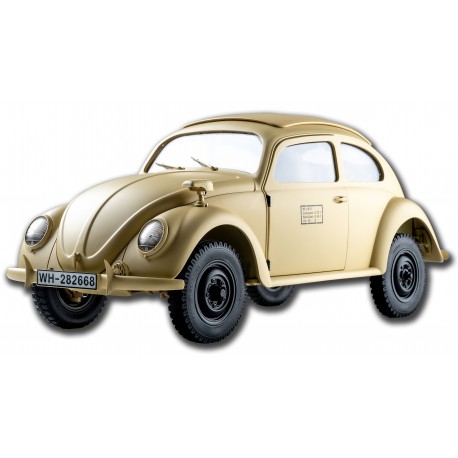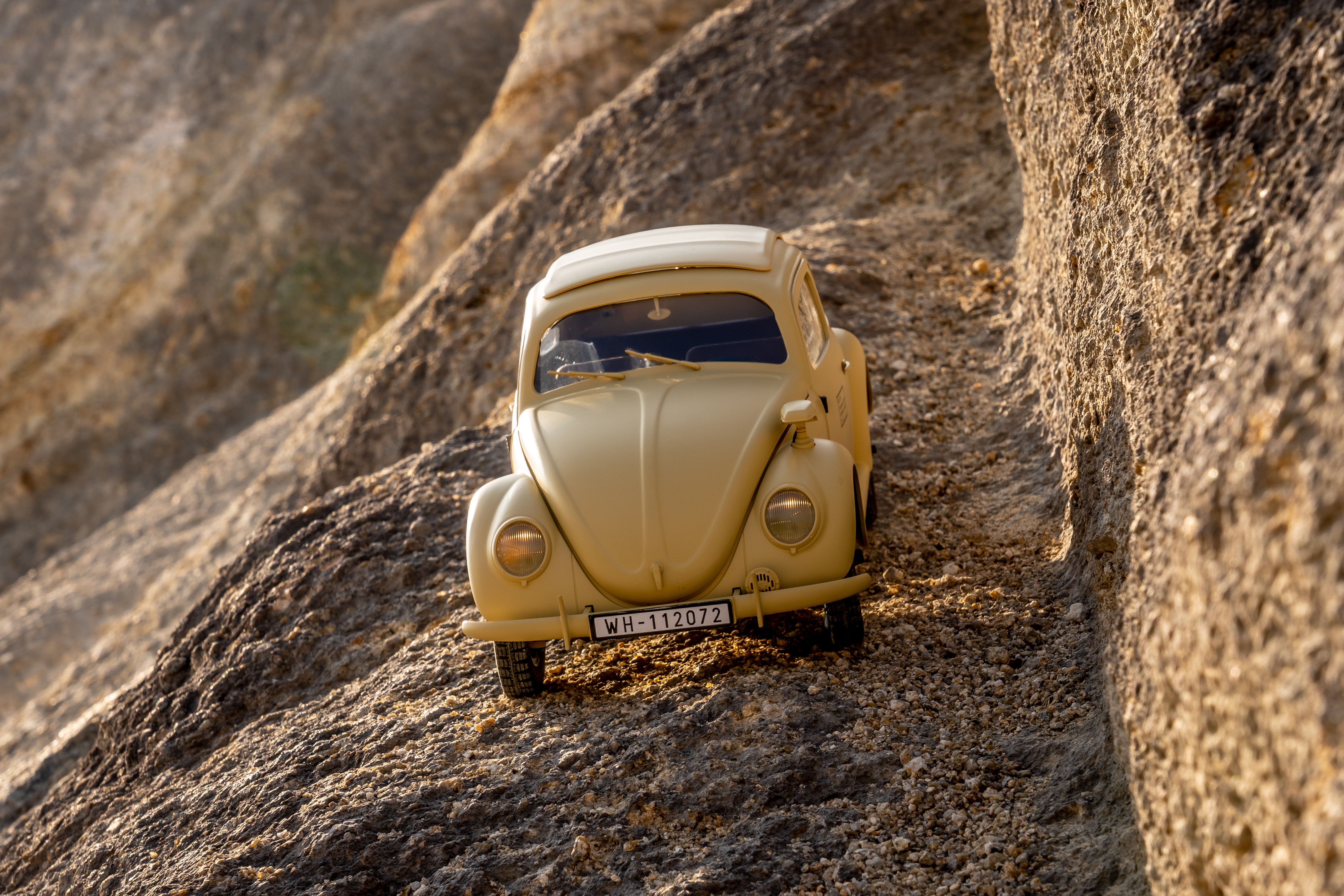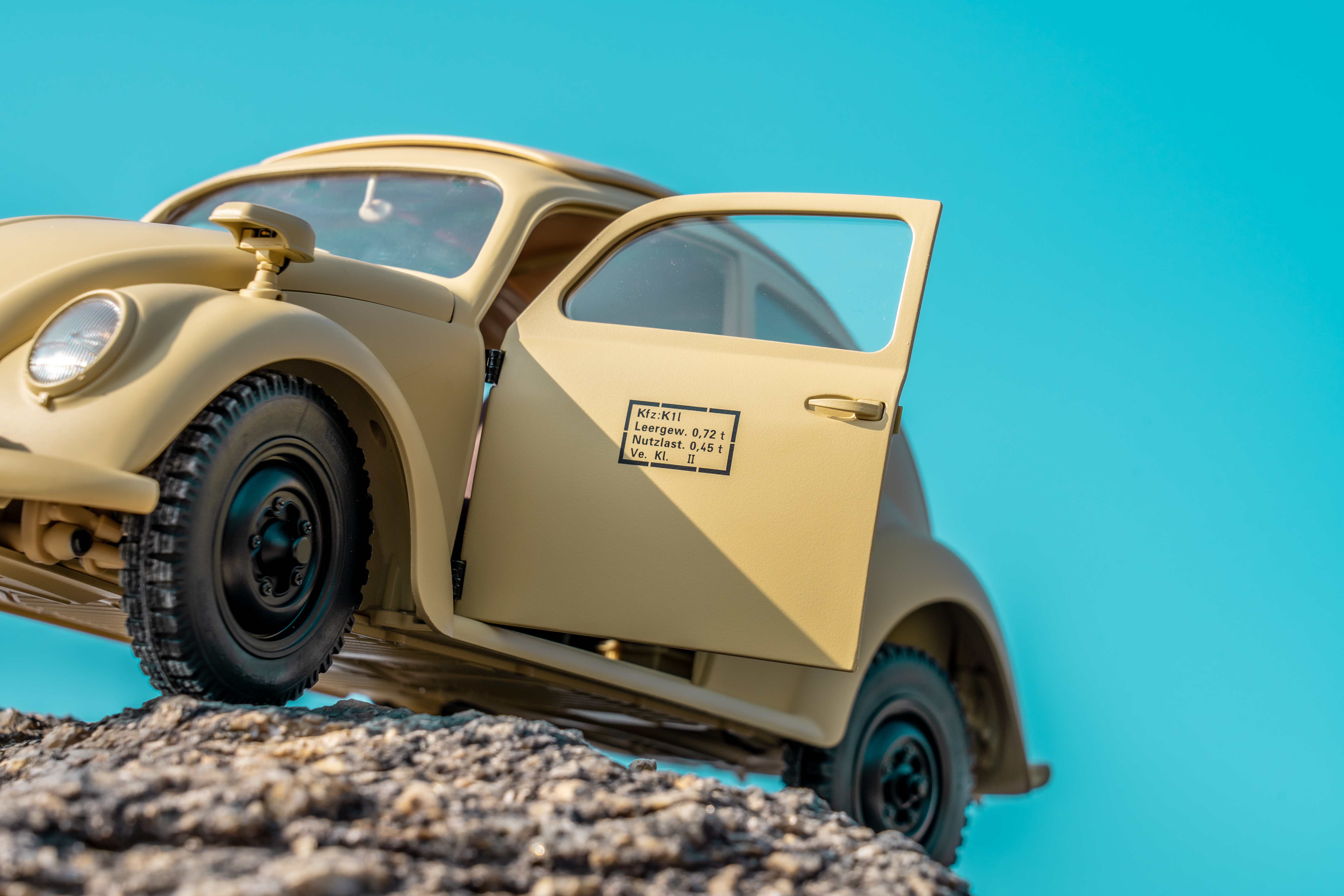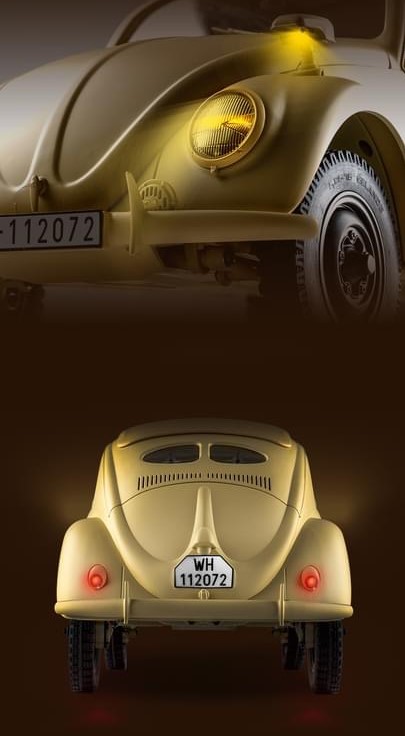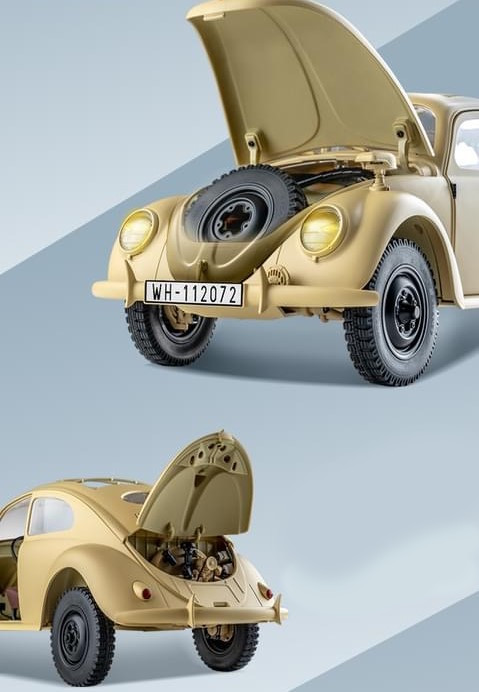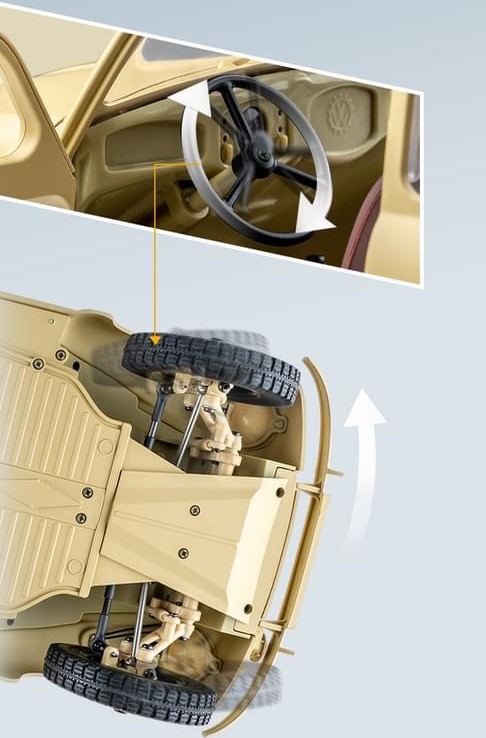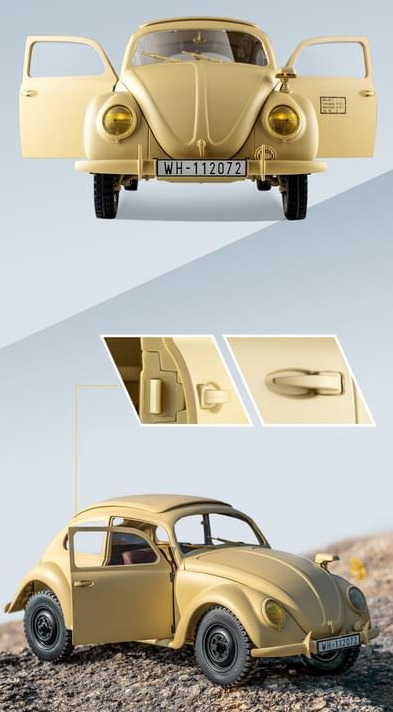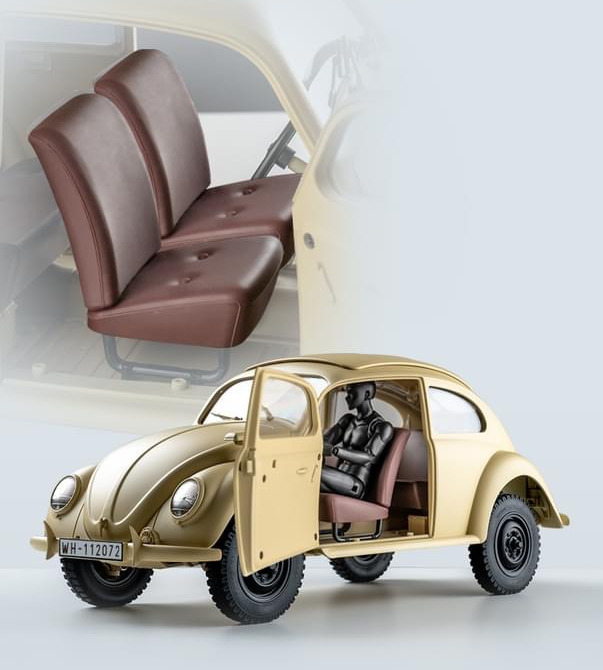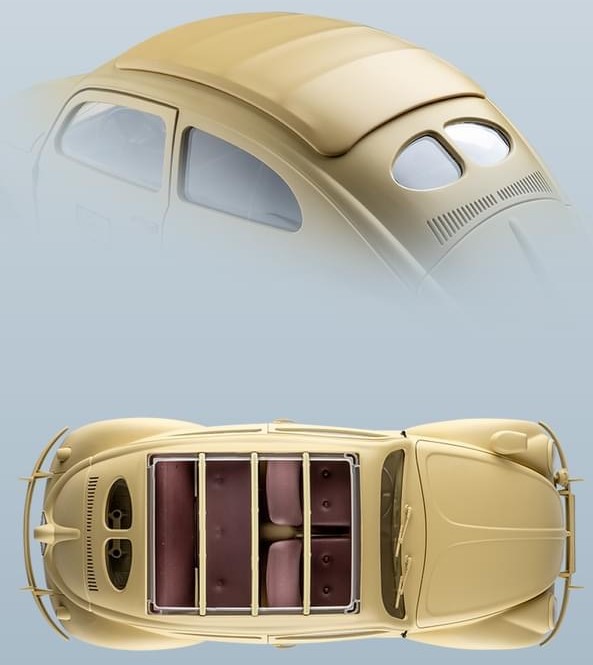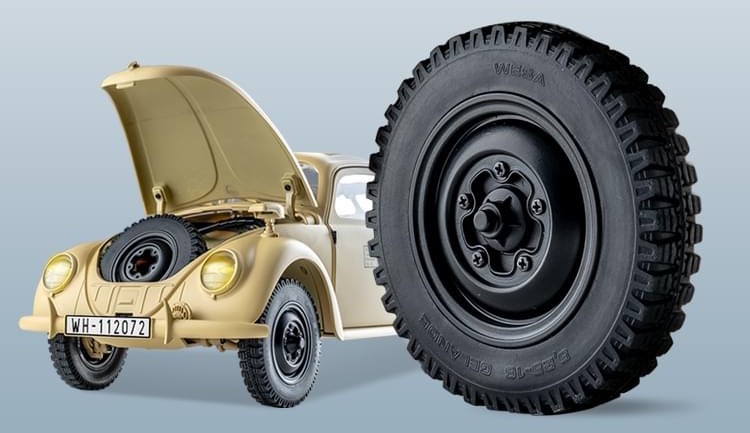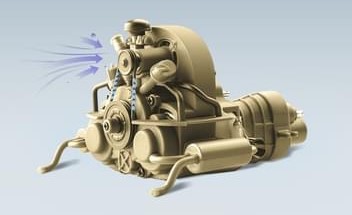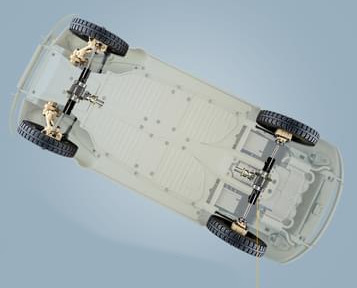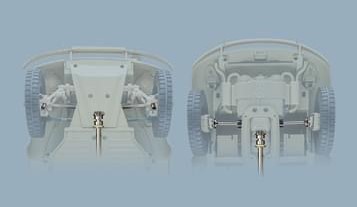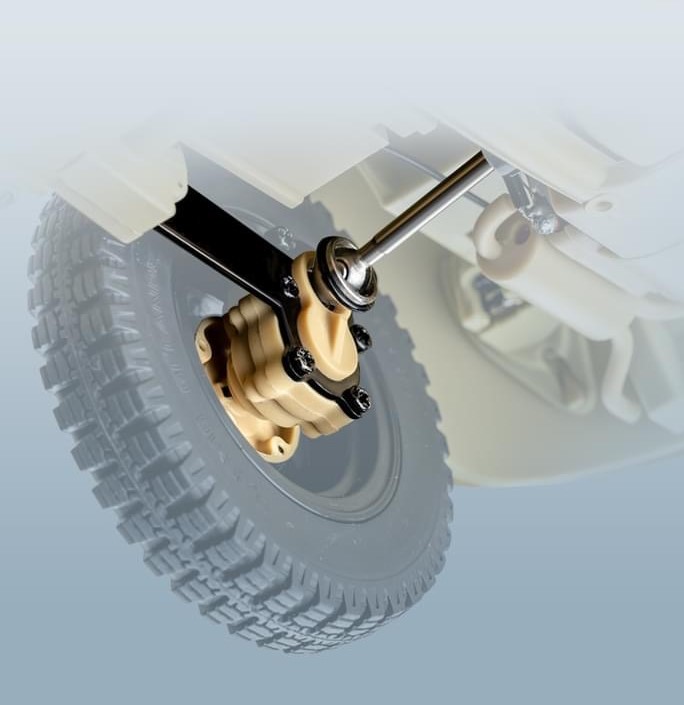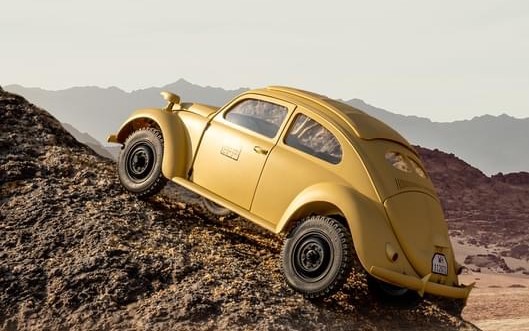DISC.. 1/12 Type 82e Beetle Kommandeurswagen scaler RTR car kit
![]() This product is in stock at our warehouse
This product is in stock at our warehouse
Meer informatie
History
Dr. Ferdinand Porsche, the founder of the Porsche Car company, was a genius designer whose design ideas have influenced many today. He has designed the Beetle, the Elephant heavy tank destroyer, the Type82 Kubelwagen, the Type166 Schwimmwagen and Lohner-Porsche Mixed Hybrid, the world's first car powered by hub-mounted motors in the wheel..
While Ferdinand Porsche was designing , Adolf Hitler was waging war across Europe and plunging the World into chaos.
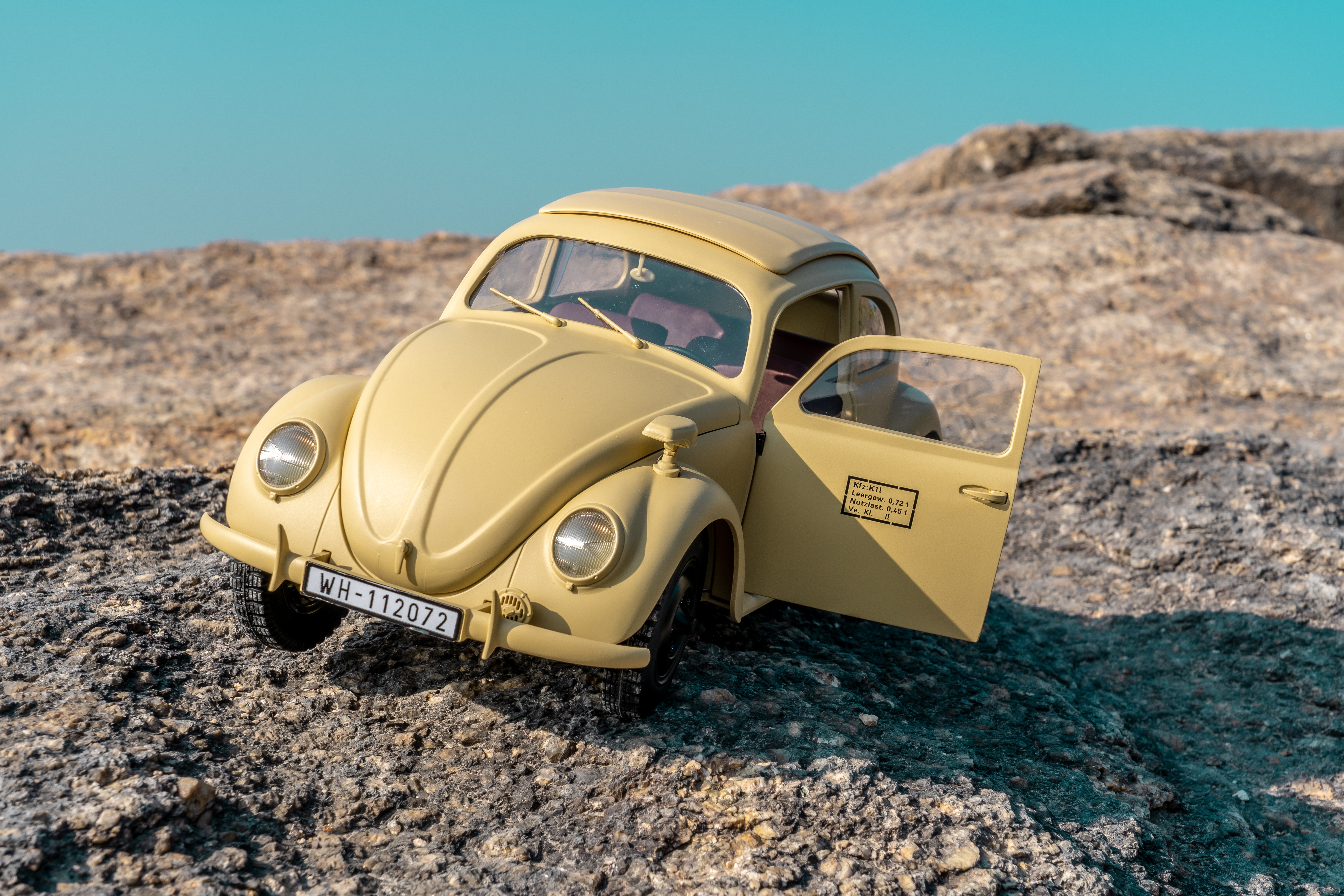
The fates of these two Austrians were intertwined in the 1930s, when Hitler made two promises to the German people after his election as head of the Third Reich: one was to have steak on dinner; the other was to have a car for every German family. The car had a very specific requirement, being able to carry 2 adults and 3 children at the same time, i.e. a standard German family, and travel at a speed of up to 100km/h, while selling for no more than 1000 Reichsmark. Then Germany built a network of dams and highways, constructed the KdF Motor City in Wolfsburg, Lower Saxony and registered the Gesellschaft zur Vorbereitung des Deutschen Volkswagens mbH, which later developed into the world-renowned Volkswagen headquarters. The national car also got its official name, KdF-Wagen, which later became the famous ‘Beetle’. kdf took the German Kraft Durch Freunde literally "Strength Through Joy", which was the name of the vacation organization under the German Labor Front at that time. At the same time, the government adopted a savings plan for the general public to buy ration coupons through this organization to pre-save for cars, which proved to be a scam set up by Hitler to raise funds for the coming war. The subsequent series of policies created a large number of employment opportunities, the economy was booming for a while and Germany was unparalleled. The people had steaks, but not cars. Then war came.
KdF-Wagen, known as the people's car while none were sold to the people, all being requisitioned by the army and converted into military vehicles, the most famous one being the Kübelwagen.
Technically speaking, Kommandeurwagen refers to the car with Beetle body based on the Type86 4WD chassis, specially provided for high officers at the front, model number Type87. Type82E, on the other hand, refers to an officer's car based on the Type82 barrel car 2WD chassis fitted with a Beetle body. The difference in appearance between the two lies in Type87’s wider fenders and footrests and larger size off-road tires.
The air-cooled engine features no need for water to cooling, making it ideal for use in hot and cold environments. Hence, it was sent in large numbers to the North African Corps under Ehrewin Rommel, which is also the prototype of our Kommandeurwagen model.
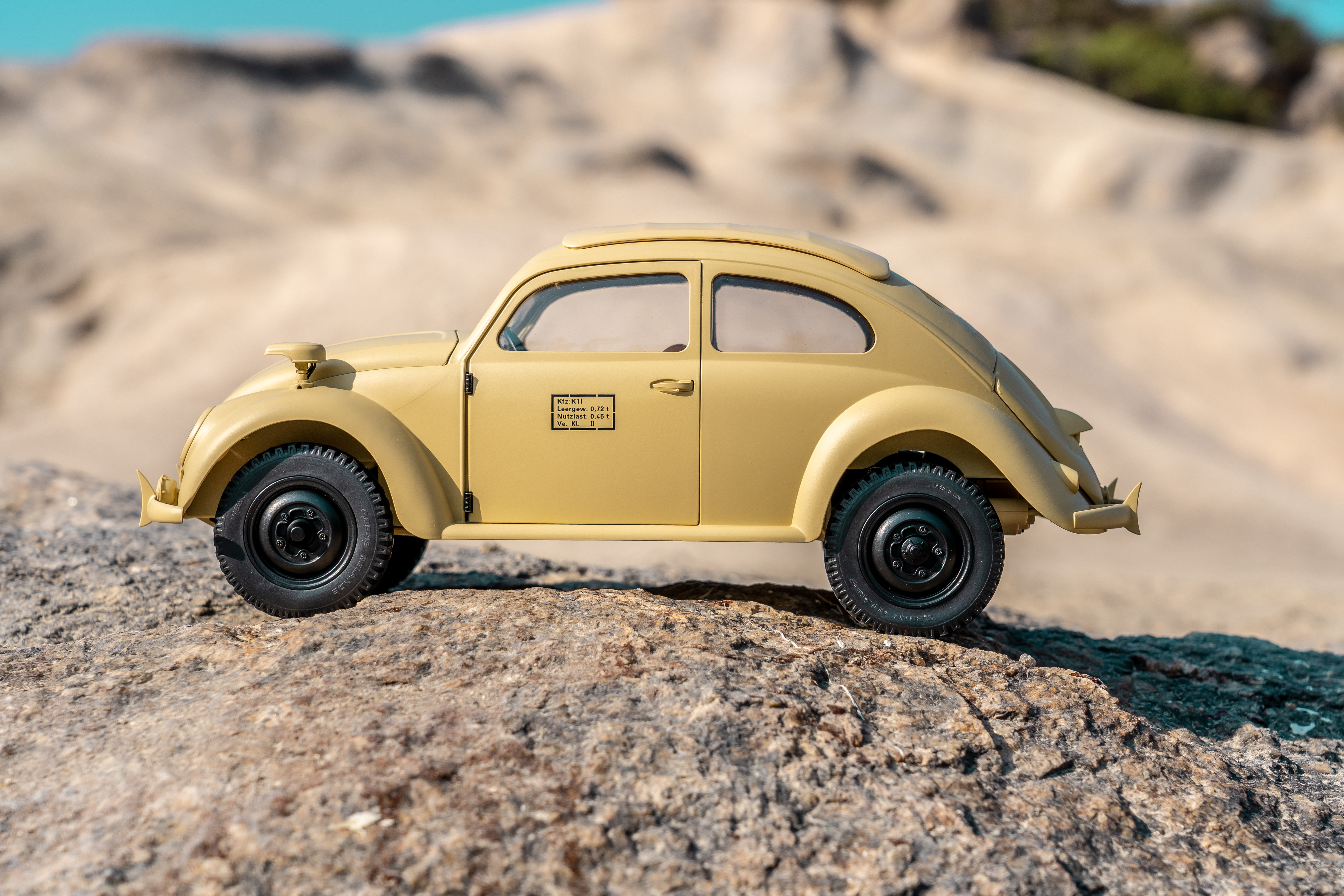
About the Model
We start with engine. The Boxer air-cooled engine serves as the core of the car, an engine used in several later generations of classic cars and lasted 65 years in the Beetle, a saga that came to an end when the last Beetle, number 21,529,464, rolled off the production line in Puebla, Mexico, on July 30, 2003. Initially the Type82 used a 985cc engine, later upgraded to 1131cc, then gradually increased displacement, and in the Porsche 356 used a 1488cc engine, doubling the horsepower from the very beginning. The cylinders of the horizontally opposed engine are distributed on both sides, a 130 motor in the right cylinder position, and another 130 motor reserved for the left side, which can output twice as much power when applied to the VW T1 or Porsche356 platform. The engine crankshaft flywheel is connected by a belt to drive the generator and the cooling fan as well. The semi-circular fan fairing is a major feature, in which the airflow is distributed to the cylinders on both sides. All is faithfully restored on the model, meaning you can observe the blades rotating through the fan intake when the motor is running. The Kübelwagen has 4 forward gears and the maximum speed of each gear respectively goes as 1st gear 18.4km/h; 2nd gear 32.4km/h; 3rd gear 54.2km/h; 4th gear 83.6km/h. The corresponding red line of gearshift tips is available on the dashboard. On the model, we designed a 2-speed shift to simulate the speed of the 1st and 3rd gears of the real car. The power crosses over from the top of the rear axle differential and then returns to the rear axle. The model shares the same structure as the real engine, with the benefit of compactness, making it easy to switch between 4WD and RWD modes. This shift function is perfectly reproduced on the model to provide more driving pleasure when driving off-road.
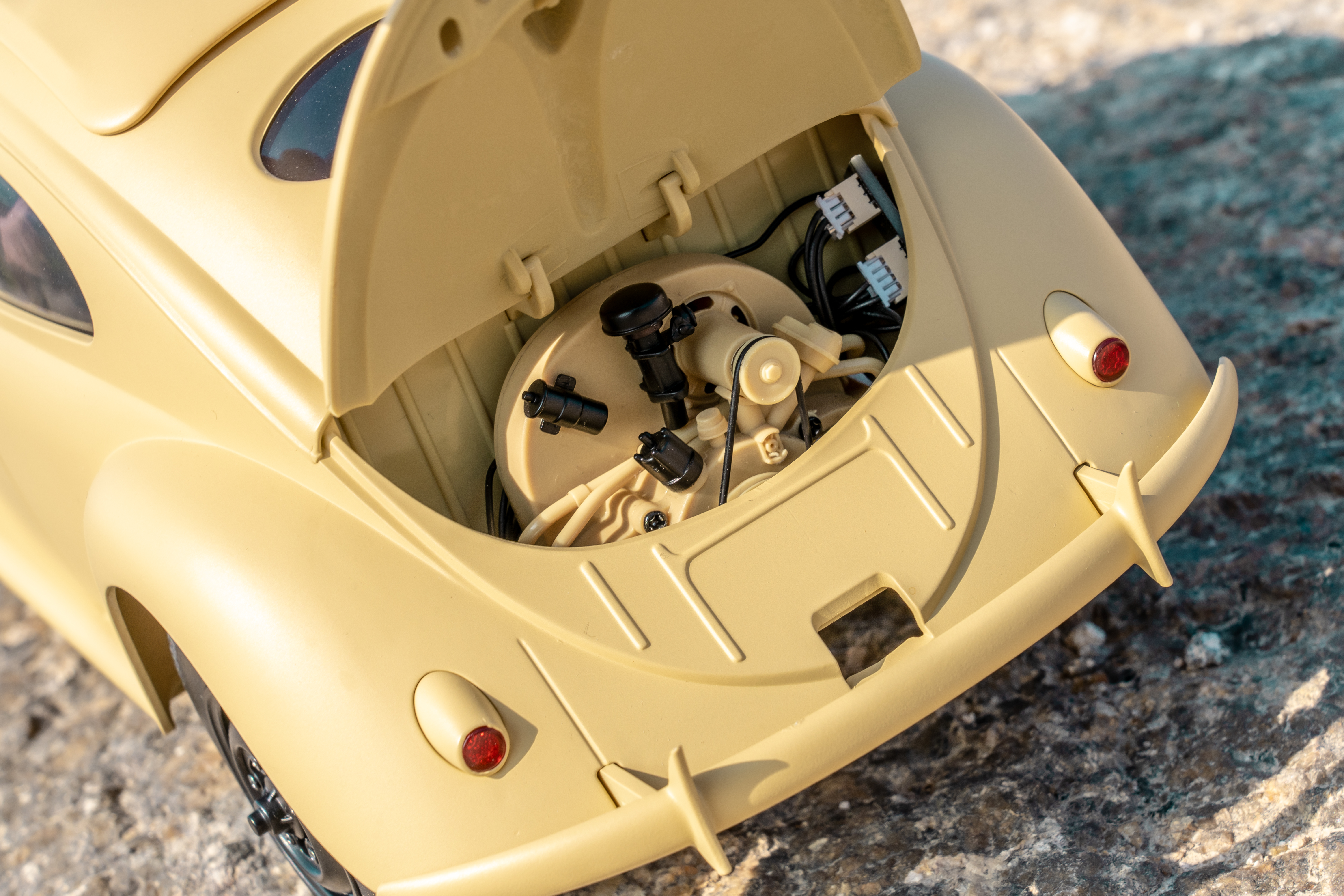
Now let’s move to chassis. The popular portal axle in today's climbing car market has been in mass production for barrel cars as much as 82 years ago, from which wheelside reducer reduction ratio of 15:21 has learned a lot, making the barrel car chassis minimum ground clearance of 310mm, dwarfing all modern off-road cars on the market today. On the real car, the front and rear wheel speeds are balanced by increasing the front axle differential gear ratio while on the model we set the door axle reduction ratio to 1:1 for common front and rear axle differentials.
Solid load-bearing chassis with stamped central ridge tube chassis and body bears high torsional resistance. The central drive shaft and electrical wiring are hidden in the ridge tube. The one piece injection model features the texture of metal stamping with plastic as location and size of each reinforcement are restored according to the actual car. The front and rear wheels adopt torsion-bar-sprung independent suspension, allowing long travel capability with little space occupation. We use torsion springs instead of torsion bar springs to present the front and rear suspension, easy to disassemble and change tuning.
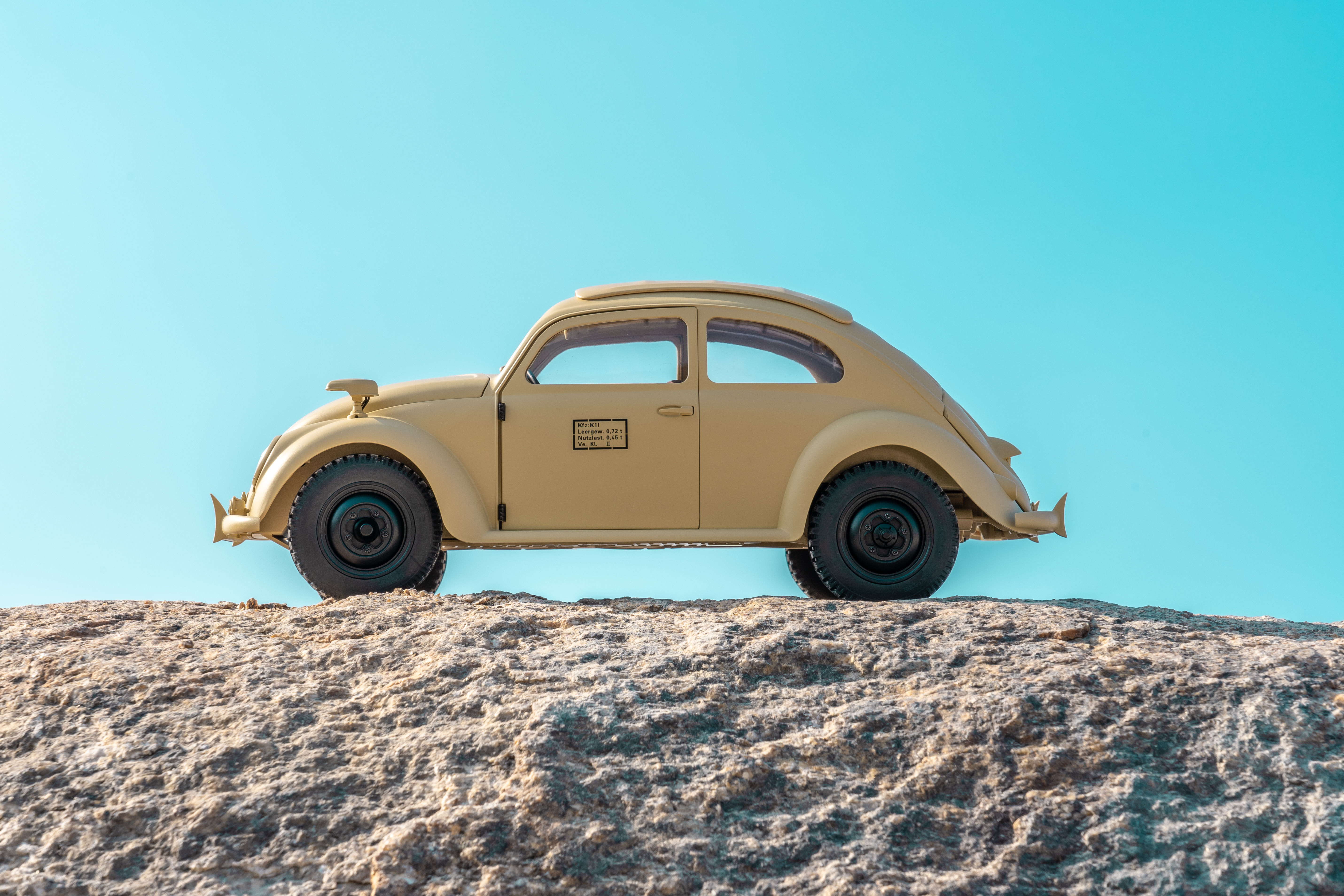
With regards to tires, the model adopts the same 5.25 x 16 off-road tires as the barrel car. The simulated wheels need to be fixed with 5 screws like the real car, and the spare tire in the front is readily accessible after opening the hood. Here you can also charge the battery at your convenience with battery properly stored in the actual car fuel tank.
Can the doors be opened? Let’s try the door handle. Pull outward- the door can be opened with the built-in spring lock push, when closed you can hear the spring lock crisp "kata" sound. Door interiors are engraved with simulated fabric texture; Soft rubber seats share the same soft texture of the actual car cushion, perfect for 1/12 figures. As FMS always does, the model features a servo operated steering wheel and front wheels for perfect synchronized action.
Generally speaking, rear passengers do not have a separate door which reduced the likelihood of a successful escape for rear officers in an emergency. To facilitate escape in the event of an attack and rollover, foldable soft canopy is set in the roof window. In the model, we set up a removable plastic roof carved with a fine weave pattern to simulate the texture of the cloth canopy. When removed, figures can be placed in the rear if you like.
For the electronic system, a 4-channel digital proportional remote control system is applied. In addition to 1&2 channels for steering and throttle control, the 3rd channel controls the gearshift and the 4th channel switching between 4WD and RWD. There is also integrated light control, which allows you to turn on the headlights during normal night driving. Linked turn signals and brake lights are at the rear of the car. Users can only turn on the anti-aircraft lights during the night light restriction.
Then comes to the packaging, which used environmental friendly foam material to simulate the World War II German ammunition tin boxes. The recyclable box can bear long-distance transport easy to store, easy to carry.
Light functions
Integrated light control, which allows you to turn on the headlights during normal night driving. Linked turn signals and brake lights are at the rear of the car. Users can only turn on the anti-aircraft lights during the night light restriction.
Openable front storage compartment hatch
Battery properly stored in the actual car fuel tank.
Servo operated synchronized steering wheel and front wheels
Openable doors with spring loaded hatch
Pull outward, the door can be opened with the built-in spring lock push, when closed you can hear the spring lock crisp "kata" sound.
Realistic soft fabric rubber seats
The soft rubber seats share the same soft texture of the actual car cushion, perfect for 1/12 figurines.
Removable plastic roof
A removable plastic roof carved with a fine weave pattern to simulate the texture of the cloth canopy.
Realistic 5.25-16 tires/wheels/spare tire
The simulated wheels need to be fixed with 5 screws like the real car, and the spare tire in the front is readily accessible after opening the hood.
130 motor in the cylinder
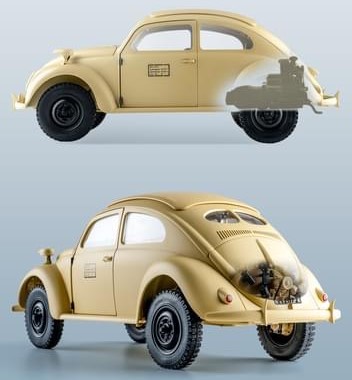
Perfect restoration of Air-cooled horizontally opposed four-cylinder engine
The engine crankshaft flywheel is connected by a belt to drive the generator and the cooling fan as well. The semi-circular fan fairing is a major feature, in which the airflow is distributed to the cylinders on both sides. All is faithfully restored on the model.
Solid load-bearing chassis
Solid load-bearing chassis with stamped central ridge tube chassis and body bears high torsional resistance. The central drive shaft and electrical wiring are hidden in the ridge tube. The one piece injection model features the texture of metal stamping with plastic as location and size of each reinforcement are restored according to the actual car.
Four-wheel independent suspension
The front and rear wheels adopt torsion-bar-sprung independent suspension, allowing long travel capability with little space occupation. We use torsion springs instead of torsion bar springs to present the front and rear suspension, easy to dissassemble and change tuning.
Full metal drive shaft
Rear portal axles
Four-channel 2.4GHz digital proportional remote control system
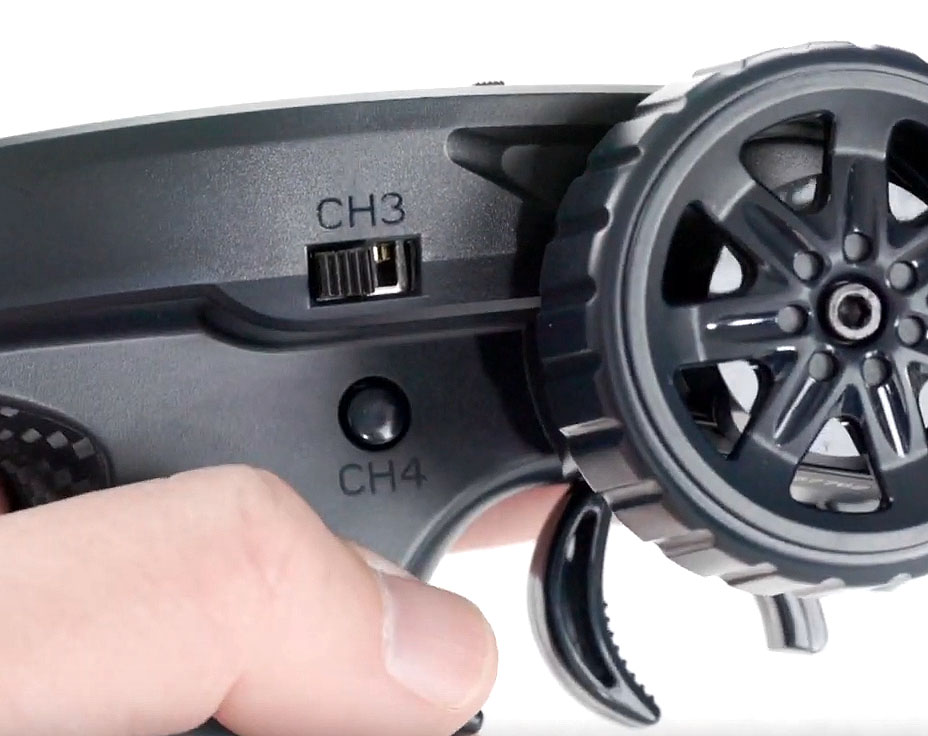
For the electronic system, a 4-channel digital proportional remotre control system is applied. In addition to 1 & 2 channels for steering and throttle control, the 3rd channel controls the gearshift and the 4th channel switches between 4WD and RWD modes when you makes a long push (3 seconds) or change the lightning mode if you makes short pushes.
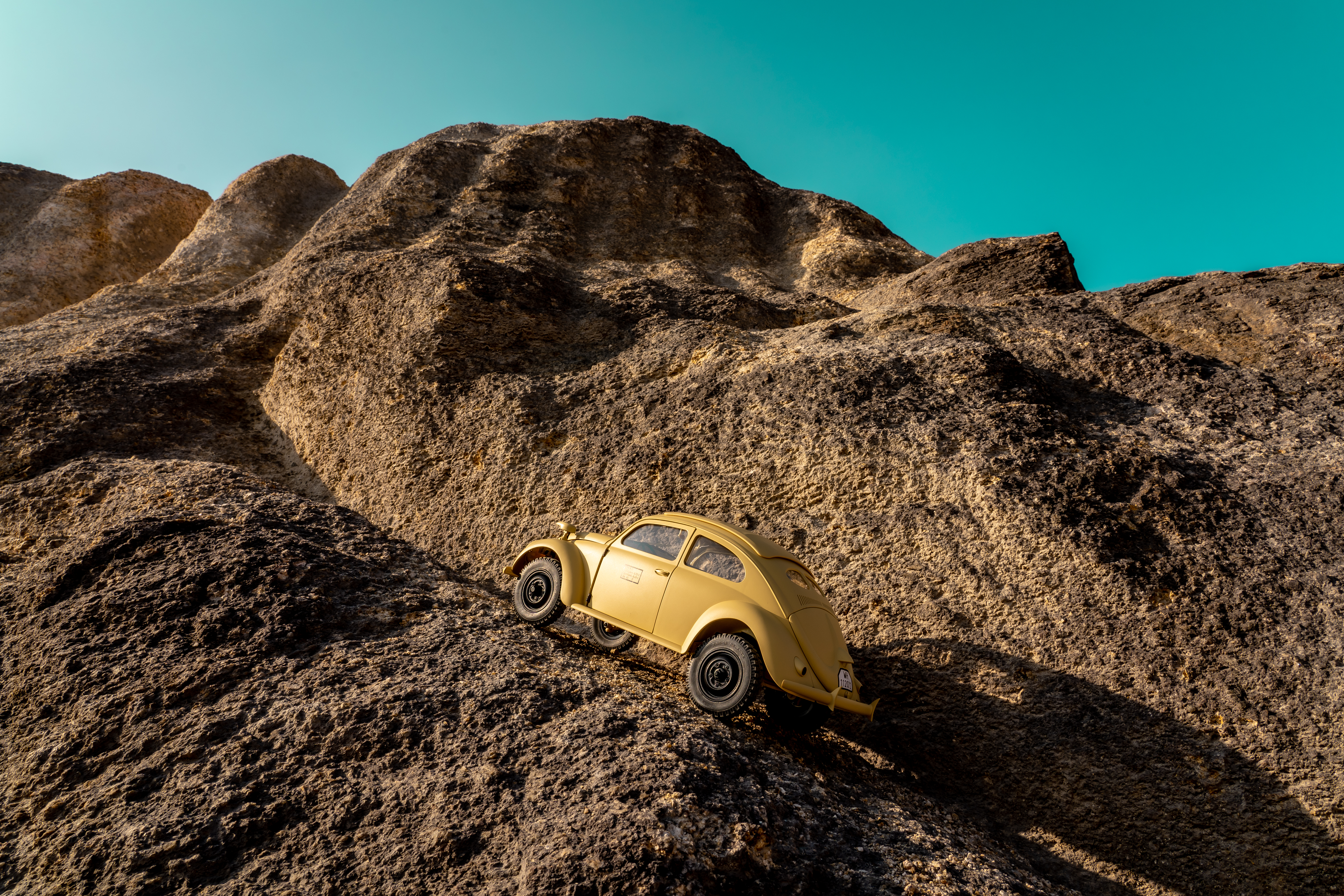
- Four-wheel independent suspension
- Rear portal axles
- Front and rear axle planetary gear differentials
- Perfect restoration of Air-cooled horizontally opposed four-cylinder engine
- 130 motor in the cylinder
- Cooling fan driven by belt
- The third channel for the two-speed transmission controls
- The fourth channel for switch between 4WD-RWD Mode
- Servo Operated Synchronized Steering Wheel and Front Wheels
- Openable doors with spring loaded latch
- Realistic fabric soft rubber seats
- Openable front storage compartment hatch
- Openable Engine hatch
- Excellent light function
- Realistic 5.25-16 tires, wheels and spare tire
- Perfect for 1/12 figures
- 30 stainless steel ball bearings
- Full metal gears
- Full metal drive shaft
- WWII German North African Desert Yellow Painting
- Exquisite pad-printed body logo
- Four-channel 2.4Ghz digital proportional remote control system
- Receiver electronic governor two in one
- 9G servo x 3pcs
| Dimensions | 339 x 139 x 139mm |
| Weight without batteries | 635g |
| Wheelbase | 202mm |
| Ground clearance | 28mm |
| Max speed | 8km/h |
| Remote distance | 60m |
| Ride time | 20min |
- 1:12 Type82E Kommandeurwagen RTR
- 2.4GHz Radio
- 2-in-1 Receiver / ESC (installed)
- 130 Brushed Motor (installed)
- 3x 9g Plastic Digital Servo (installed)
- 7.4V 380 mAh Battery
- USB Battery Charger
- Hex Wrench Socket
- Product Manual
AAA Batteries for Radio
- Manufacturer : RocHobby

